
8 Plant-Microbe Interactions
Plants work with microbes to live and are never by themselves.
Plants - in particular - form good working relationships with nitrogen-fixing bacteria (i.e., bacteria that take atmospheric nitrogen and convert it into ammonium) and also fungi.
8.1 Nitrogen
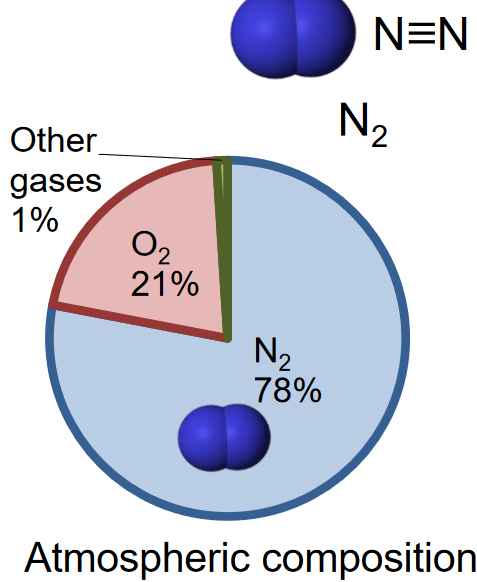
Nitrogen is a crucial element in the world of biology. It’s actually the fourth most abundant element across all living things.
Even though there’s a lot of nitrogen in the atmosphere, it’s not in a form that most organisms can use directly. The nitrogen in the air is locked up in a molecule with a triple bond between nitrogen atoms, which makes it very stable. To make it accessible to plants and other organisms, this triple bond needs to be broken. This process is called nitrogen fixation, and it results in the creation of compounds like ammonia (NH3) or nitrate (NO3-), which can be used as sources of nitrogen for plants and, in turn, for animals higher up the food chain. So, nitrogen fixation is like the key that unlocks the nitrogen stores in the atmosphere and makes it available for life on Earth.
8.1.1 Industrial Nitrogen Fixation
Industrial nitrogen fixation, often referred to as the Haber Process, is a remarkable human-made method to produce ammonium (NH4+) from the nitrogen (N2) in the air. This process was discovered in 1909 by Fritz Haber and Carl Bosch. It involves the use of high temperature, high pressure, and an iron catalyst to convert nitrogen gas and hydrogen gas into ammonia. This discovery has had a profound impact on our world. Currently, it provides the basis for roughly half of the world’s population to have enough food, as ammonia is a key component of synthetic fertilizers. However, it’s important to note that this process consumes a significant amount of energy, accounting for around 2% of the world’s energy usage.
Interestingly, some plants have developed a natural ability to perform nitrogen fixation using bacteria as “factories,” and they can do this under normal atmospheric conditions. This is like having tiny nitrogen-fixing powerhouses within the plant. When you compare the amounts, you’ll find that per year:
- Biological nitrogen fixation on land contributes about 90-140 teragrams (Tg, equivalent to 10^12 grams) of nitrogen to ecosystems.
- The Haber Process contributes approximately 100 Tg of nitrogen globally.
- Lightning, through its natural ability to create reactive nitrogen compounds, contributes around 10 Tg of nitrogen.
These numbers illustrate the remarkable balance between natural and human-driven nitrogen fixation processes that sustain life on Earth, from plant growth to the food we eat.
8.2 Biological Nitrogen Fixation
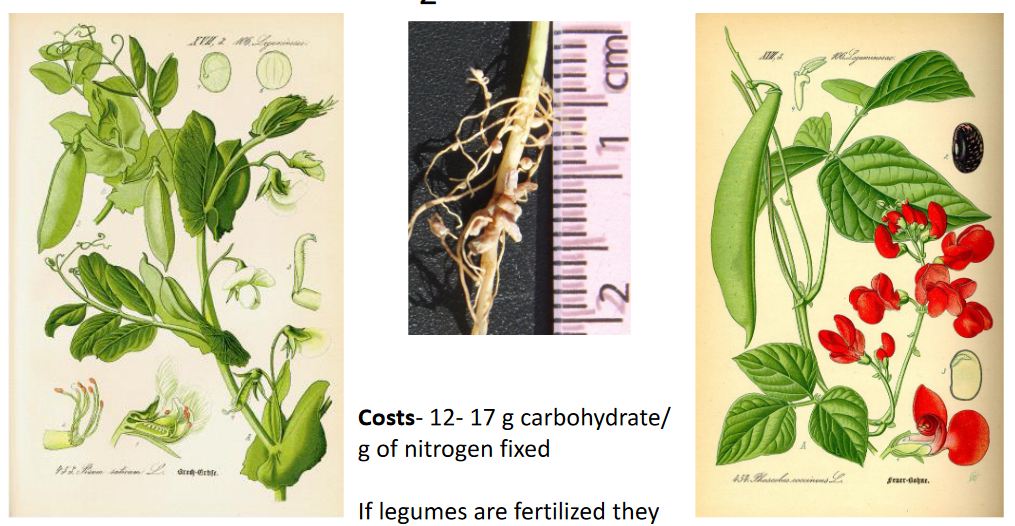
In plants, the root nodule is the special place where a fantastic natural process called biological nitrogen fixation happens.
This process allows the plant to convert atmospheric nitrogen (N2) into a form it can use for growth and development. It’s like having a mini nitrogen factory right at the roots.
However, this incredible process doesn’t come for free. It comes at a cost. To be more specific, it takes about 12 to 17 grams of carbohydrates to produce just one gram of fixed nitrogen. These carbohydrates are the plant’s way of paying for the services of the nitrogen-fixing bacteria that reside in the root nodules. In a sense, it’s like giving these bacteria a little snack to motivate them to keep working.
Interestingly, if legume plants are given nitrogen-based fertilizers, they might decide to skip the whole root nodule formation process. It’s like the plant saying, “Why go through all the trouble of hosting these nitrogen-fixing bacteria if we’re getting our nitrogen from elsewhere?” This ability to suppress nodule formation is a fascinating way that plants can adapt to changing nutrient conditions.
8.2.1 Rhizobia Symbiosis
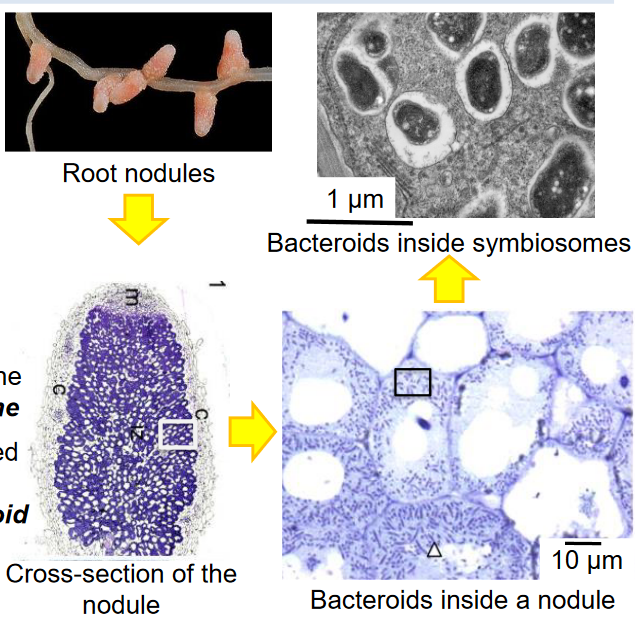
The partnership between rhizobia bacteria and legume plants is considered one of the most advanced and intricate nitrogen-fixing symbioses in the natural world.
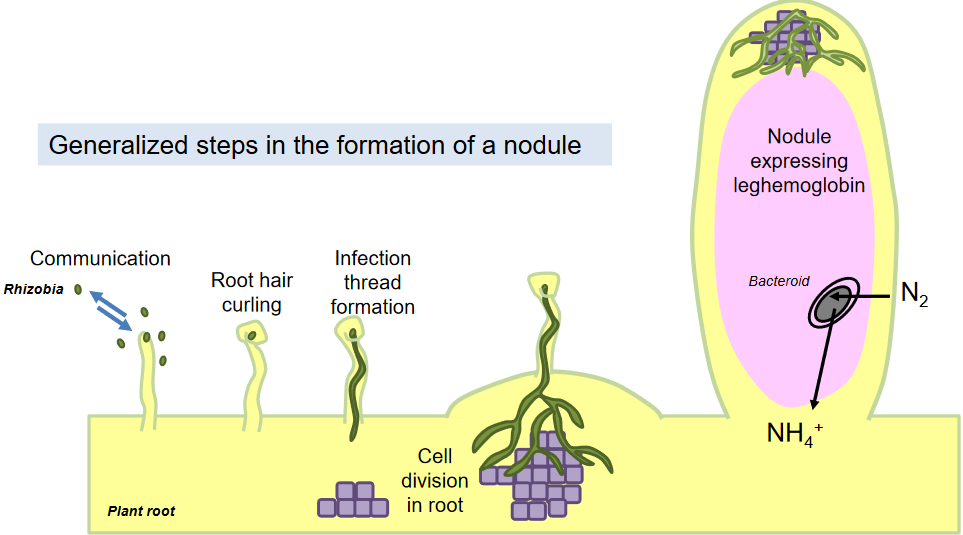
The rhizobia bacteria and legume plant work together in a special way, and it all centers around a unique structure called the nodule. This nodule is essentially a modified root organ that is specially designed to host these endosymbiotic rhizobia bacteria and facilitate nitrogen fixation. It’s like a dedicated factory for producing nitrogen.
When the plant and rhizobia come into contact, something fascinating happens. The rhizobia undergo a transformation, changing into specialized forms called bacteroids. These bacteroids are then enclosed within the plant’s cells, and they reside in a compartment known as the symbiosome. It’s like the plant invites the rhizobia in for a friendly chat and locks them in a cozy room.
This symbiosome is enclosed by a specialized membrane called the peribacteroid membrane, which is like the protective barrier around this unique partnership. This well-organized collaboration allows the plant to efficiently obtain the nitrogen it needs, while the rhizobia bacteria have a safe place to work their nitrogen-fixing magic. It’s a sophisticated example of teamwork in the plant world.
8.2.2 Plant-Microbe Communication
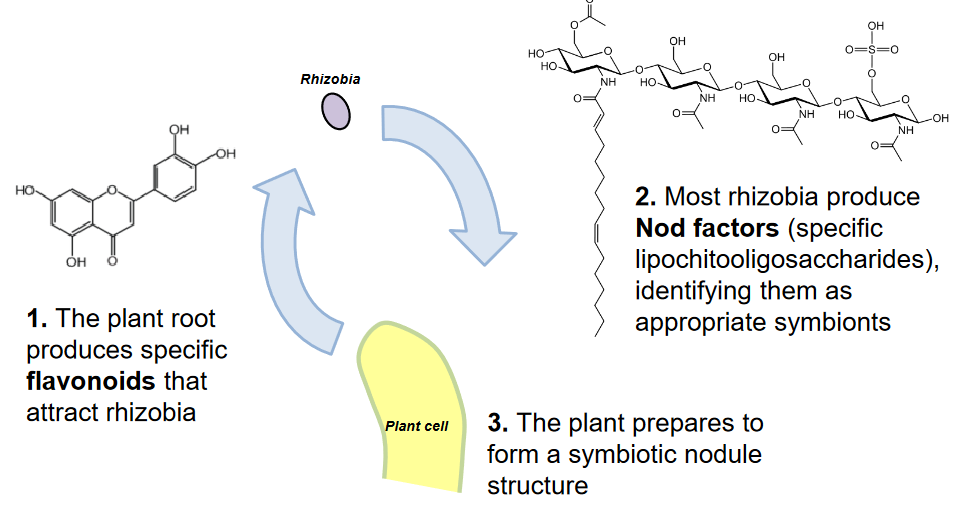
Communication between plants and microbes, like rhizobia, is a fascinating process involving several important steps:
Flavonoid Attraction: It all starts with the plant’s roots. They produce specific compounds called flavonoids. These flavonoids act like a signal to attract the rhizobia bacteria. It’s like the roots are sending out an invitation, saying, “Hey, we’re ready for a guest!”
Nod Factors: In response to the invitation from the plant, most rhizobia bacteria produce something called Nod factors. These Nod factors are specific lipochitooligosaccharides, which are essentially complex molecules. These factors serve as a way for the rhizobia to identify themselves as the right partners for this plant. It’s like presenting a badge at a secure entrance, showing they belong.
Plant Preparation: When the plant receives the Nod factors and confirms that the rhizobia are the right guests, it starts getting ready to form a symbiotic nodule structure. This structure is like a cozy home where the rhizobia can live and work, creating a beneficial partnership for both the plant and the bacteria. It’s like the plant and the rhizobia are in constant communication, making sure they’re on the same page and ready to work together to fix nitrogen.
8.2.2.1 Detecting Nod Signals
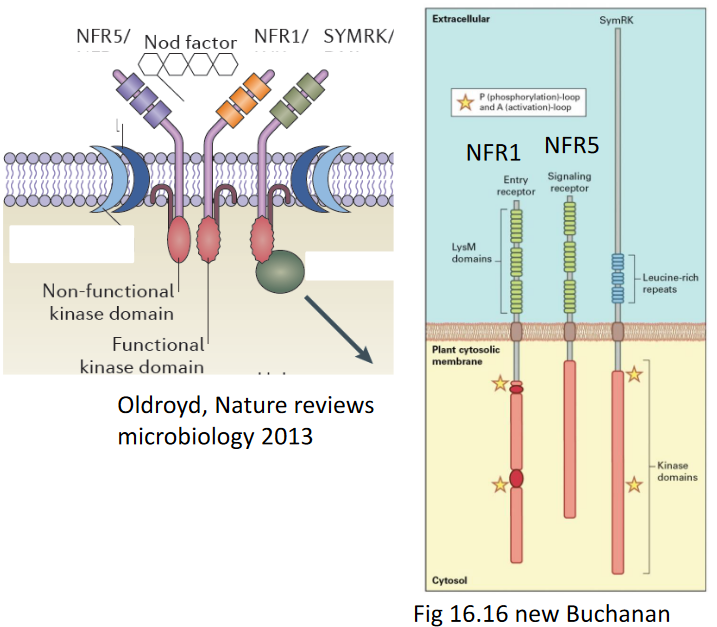
Plants have a special way of detecting a signal called the “Nod factor.” This signal is like a message from friendly bacteria called rhizobia. It’s how the plant knows when the right guests, the rhizobia, have arrived.
To understand this signal, think of it like a lock and key. The plant has special parts called “LysM domains” on proteins named NFR1 and NFR5. These LysM domains act like the keyholes. The Nod factor, which is a part of the rhizobia, is like the key. When the Nod factor fits into these keyholes, it’s like the plant recognizing the right key.
Now, here’s where the magic begins. LysM domains usually like to stick to carbohydrates. But when they find the Nod factor, it’s like they’ve found something special. This starts a chain reaction, a bit like a domino effect.
In this chain reaction, a special protein called SymRK (short for symbiosis receptor kinase) plays a crucial role. Think of SymRK as the conductor of an orchestra. It helps guide the process and makes sure everything goes smoothly. It’s like the plant’s way of saying, “We’re ready to start the show,” and the show is the amazing partnership between the plant and the rhizobia to make nitrogen-fixing nodules.
8.2.2.2 Calcium Spiking from Nod Factors
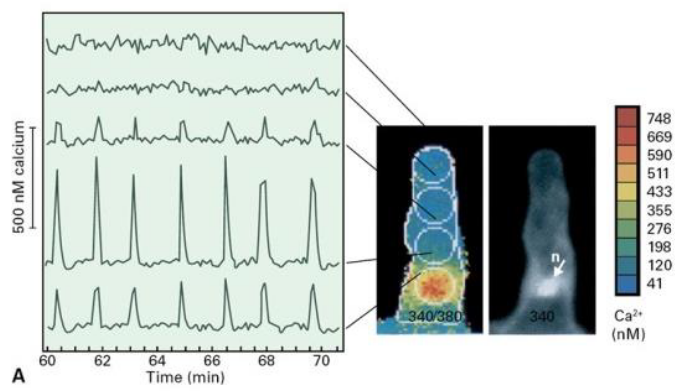
When the plant detects the Nod factor, it triggers something called “Calcium spiking.” This might sound complex, but it’s a common way cells communicate.
Think of Calcium spiking like a special Morse code between cells. It’s a pattern of signals that tells the cells to get ready for action. Interestingly, this pattern is not unique to plants. Some animals use a similar pattern in their cells for important tasks. One example is the Sonic hedgehog signaling, which might sound familiar if you like superheroes!
To make this Calcium spiking happen, the plant needs three important things:
- A reservoir of Calcium: Think of this as a storage tank for Calcium ions.
- A channel to release Calcium: This is like opening a gate to let the Calcium ions flow.
- An energy-dependent Calcium pump: This pump is like a machine that restores the Calcium levels back to where they started, ready for the next signal.
8.2.2.3 Nodulation Requirements

For nodulation to happen, a specific protein kinase needs to get activated. This kinase is like a conductor that directs the process.
To activate this kinase, something called calmodulin comes into play. Calmodulin is a common protein that’s good at binding to calcium, and it’s found in many different organisms. When calmodulin grabs onto calcium, it changes its shape, a bit like how a transformer changes form.
Now, here’s the teamwork part. Calmodulin teams up with CcaMK (short for calcium-calmodulin-activated protein kinase). Together, they work like a dynamic duo. They’re responsible for turning on the genes that produce nodulin proteins. Nodulins are special proteins that are only found in nodules. They’re like the construction workers of the nodules, doing the specific jobs needed to make this whole process work.
8.2.3 Root Hair Invasion
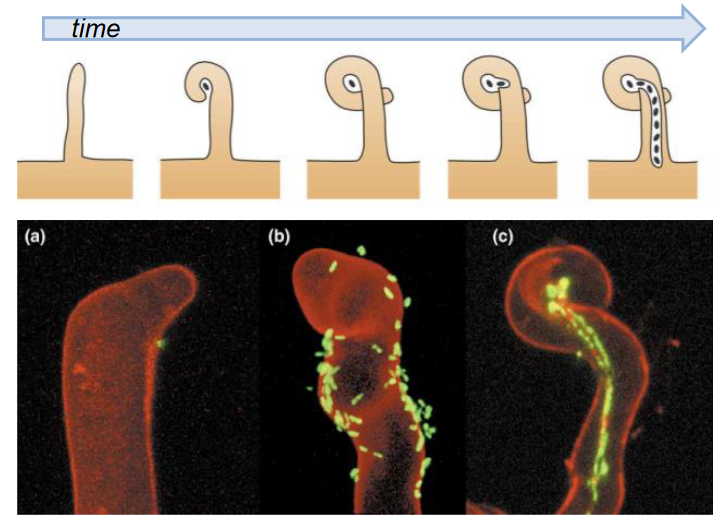
When rhizobium bacteria want to make themselves at home in a plant’s roots, they start by sending out something called “Nod factors.” Think of these as their way of saying, “We’re here!”
Now, the plant’s roots are pretty clever. They receive this signal and decide to change things up. The root hairs, which are like tiny hair-like structures on the root’s surface, respond by changing their growth pattern. It’s almost like they’re shifting their shape to trap the bacteria, kind of like creating a cozy little home for them.
As the root hairs do this, something interesting begins to happen. An “infection thread” starts forming. This is like a tunnel made of plant cell wall material. And here’s the cool part: it grows from the outside in. It’s as if the plant is constructing a special passage for the bacteria to come in. This way, the bacteria can move deeper into the root, and the plant and bacteria can start their helpful partnership. It’s a bit like building the entrance to a secret underground club for beneficial bacteria!

The “infection thread” we talked about earlier doesn’t stop at the front door. It goes further, like a tunnel penetrating several layers of the host plant’s cells. It’s almost like making a highway for the bacteria to travel through the plant’s roots.
Once inside, the bacteria are released into special compartments called “symbiosomes.” These compartments are like little rooms, and what’s cool is that their walls are made from the plant itself. It’s like the plant creates cozy, plant-made homes for the bacteria.
Now, inside these symbiosomes, something really interesting happens. The bacteria start to change and become something called “bacteroids.” Think of it like a superhero transformation!
To make these symbiosomes even more special, the plant adds specific proteins to their walls. These proteins are like super useful tools. One of them, for example, acts like an ammonium channel, helping with the flow of nitrogen. Another, called an aquaporin, is like a water channel, making sure there’s enough water for everyone.
8.3 Nitrogen, Oxygen, and Phosphorous
8.3.1 Nitrogenase
\[\begin{equation} N_2 + 16ATP + 8e^- + 8h^+ \longrightarrow 2NH_3 + H_2 + 16 ADP + 16 P_i \end{equation}\]
Nitrogenase is like a special machine, but it’s quite picky. It doesn’t like oxygen, and it only works in certain tiny organisms called prokaryotes (like bacteria).
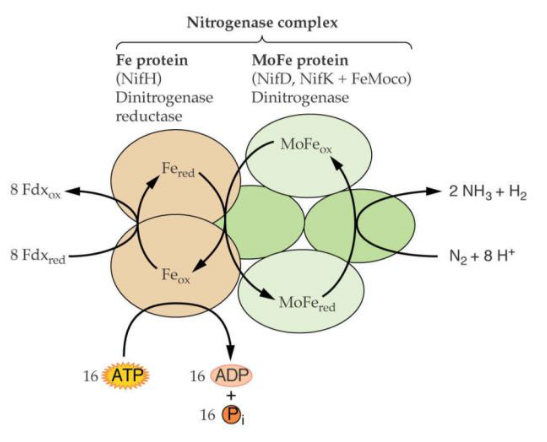
Now, here’s the challenge: making nitrogenase work requires a lot of energy, which is stored in a molecule called ATP. It’s like needing a lot of batteries to power a device.
But here’s where it gets interesting. Inside the root nodule, where this whole nitrogen-fixing process is happening, the environment is just right. It’s not too full of oxygen; instead, it’s just a little bit of oxygen, kind of like a sweet spot. And that’s perfect for nitrogenase to do its job and help turn nitrogen gas into a useful form for the plant. It’s like having the ideal conditions for a machine to run smoothly.
8.3.2 Making a Low Oxygen Environment

To keep the root nodule’s oxygen levels low, there are three clever strategies at play:
Barrier for Oxygen: Imagine the nodule as a fortress. It has a special barrier in the nodule’s tissue that controls the entry of oxygen. How it works exactly is a bit of a mystery, but it’s like a security system that keeps unwanted oxygen from getting inside.
Leghemoglobin: Legumes have a unique protein called leghemoglobin. This protein is a pro at binding to oxygen. It’s found in high concentrations, kind of like having a lot of sponges to soak up any extra oxygen that might sneak in. Leghemoglobin ensures the oxygen is locked up and doesn’t cause trouble.
Bacterial Oxygen Sink: The bacteria in the nodule are pretty smart too. They use a special tool called “cytochrome oxidase” for their respiration. This tool has a super-low threshold for oxygen. In other words, it grabs onto any oxygen it finds very quickly. This means that the bacteria actually help soak up any oxygen that might be hanging around in the nodule. It’s like having little oxygen-eating machines working alongside the plant.
8.3.3 Metabolite Exchange
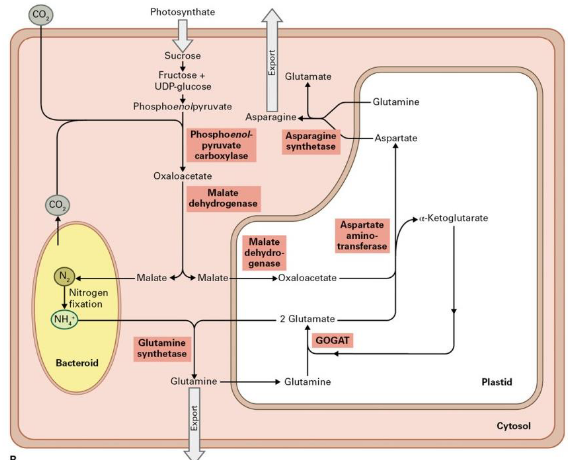
In the partnership between the plant and the bacteria in the root nodules, there’s a cool exchange going on. The plant sends over something called photosynthate. This is like the energy it gets from sunlight and carbon dioxide during photosynthesis. But instead of sending this energy directly, it first transforms it into special compounds called dicarboxylic acids. These compounds act as a kind of meal for the bacteria, providing them with nourishment.
Now, it’s the bacteria’s turn to give back. They take these dicarboxylic acids and do something amazing. They use them to create energy (like a power source) called ATP and some important molecules called reducing equivalents. These reducing equivalents are like the magic ingredients needed for the nitrogen-fixing process to work. It’s a bit like the bacteria are cooking up the perfect recipe to help the plant.
As a result of all this cooking, the bacteria produce a special substance called ammonia. But the story doesn’t end there. The plant is really clever too. It takes that ammonia and turns it into something called glutamine with the help of an enzyme called glutamine synthetase. Glutamine is like a super-nutrient for the plant.
Now, the plant can use this new nitrogen-rich glutamine to feed its other parts. It’s a bit like sharing a delicious meal with different members of the plant’s family, making sure everyone gets what they need to grow and thrive.
8.3.4 Phosphorous
Phosphorus is a vital nutrient for plants, kind of like how we need essential vitamins to stay healthy. But there’s a bit of a challenge. The phosphorus plants need is often stuck in the soil, and it’s not very easy for plants to access. It’s like having a valuable treasure buried deep underground.
To overcome this, plants have developed some smart strategies. Some plant roots are like little miners. They release substances called carboxylic acids and enzymes known as phosphatases. These work together to make the soil’s phosphorus more accessible to the plant. It’s a bit like having special tools to dig up that buried treasure.
The carboxylic acids have a cool trick – they can grab onto metal ions in the soil. These metal ions are like guards, protecting the phosphorus. When the carboxylic acids bind to the metal ions, it’s like they distract the guards, allowing the plant to snatch the phosphorus away from the soil. It’s a bit like a clever heist in the plant world.
The phosphatases, on the other hand, are like the plant’s digestion system. They break down organic phosphates, which are like different forms of the treasure, making them easier for the plant to use. So, it’s a two-step process – first, they steal the treasure from the guards, and then they turn it into a form the plant can actually use to grow and thrive. It’s all about being resourceful and efficient in the plant’s quest for phosphorus.
8.4 Mycorrhizal Fungi
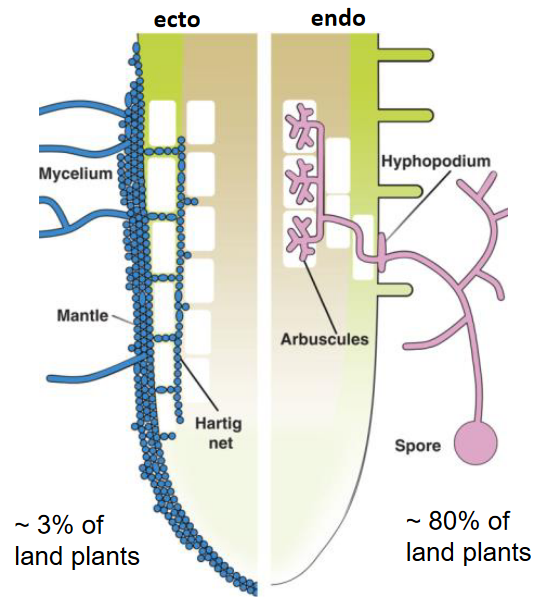
Mycorrhizal fungi are like nature’s friendly helpers for most land plants. These fungi make their home in the roots of plants. It’s almost like they set up camp there.
These fungi have super-long, thin threads called hyphae that reach out into the soil. They’re like little explorers on a mission. What they do is pretty cool. They gather water and important minerals, especially something called “Pi” (which is short for phosphate), from the soil. And guess what? They don’t keep all these goodies to themselves. They share them with the plant, kind of like a sharing buddy.
Now, there are two types of mycorrhizal friendships. One is called “ectomycorrhiza,” where the fungus stays outside the plant cells. It’s like they’re giving the plant a helping hand from the outside.
The other type is “endomycorrhiza,” where the fungus goes a step further. It actually goes inside the plant cells. It’s like inviting a friend into your house.
But the most common and popular type of mycorrhiza is called “arbuscular mycorrhiza.” In this one, the fungi create tree-like structures called “arbuscules” right inside the plant cells. It’s like having little forests inside the plant.
These fungi are so good at what they do that the mass of their tiny threads, called mycelium, can be as big as the plant’s own roots. It’s like having a whole team of helpers making sure the plant gets all the water and minerals it needs.
8.4.1 Communicating Between Fungi and Plants
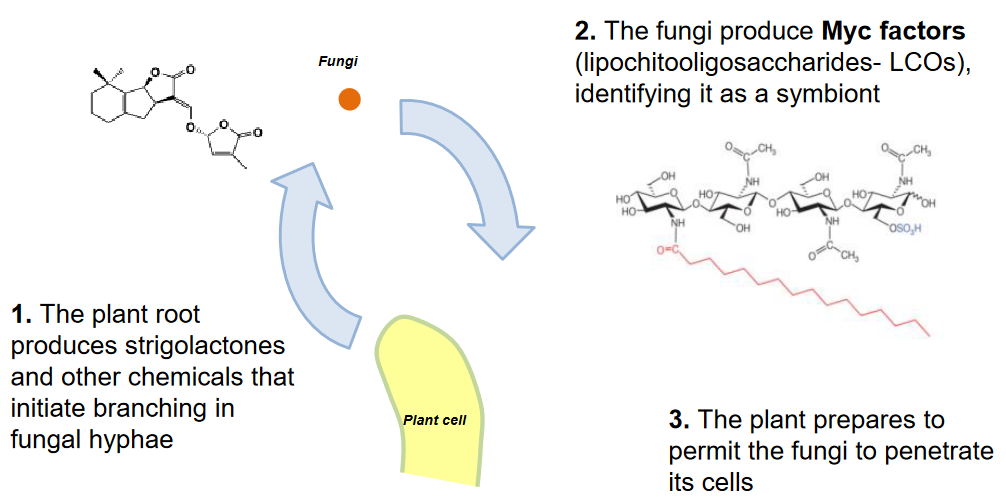
Plants and fungi have their own secret language to talk to each other. Here’s how they do it:
The plant’s roots send out special signals called “strigolactones” and other chemical messages. These signals tell the fungal hyphae (those long, thin threads of the fungus) to start branching out. It’s like the plant is saying, “Hey, we’re ready for you to join us!”
The fungi have their own way of talking back. They produce something called “Myc factors,” which are a fancy name for lipochitooligosaccharides (or LCOs for short). This is like their way of saying, “We’re here to help, and we’re friendly!”
The plant, in response, gets ready to let the fungi inside its cells. It’s like opening the door and inviting your friends over for a visit. The plant knows that these fungi are here to team up and work together.
8.4.1.1 Regulating Myc Factors
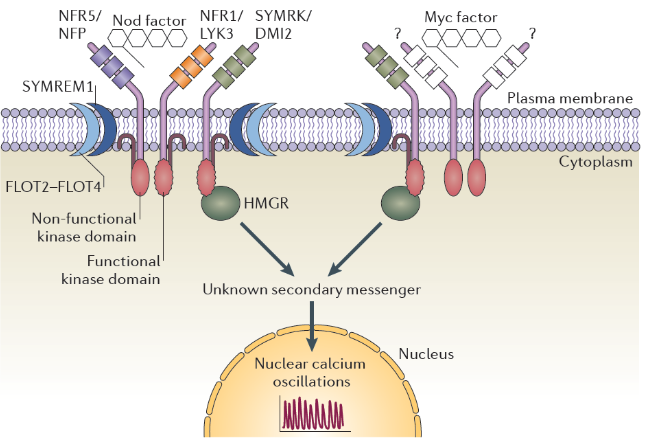
Recognizing Myc factors is a bit like finding a friend in a crowd. We’re not exactly sure how it works, but it’s kind of similar to how the plant recognizes Nod factors, which are signals from bacteria. There are some special receptors involved, but we don’t know exactly what they are yet. It’s a bit of a mystery!
Just like in the Nod factor recognition, a protein called SymRK is also needed to make this recognition process happen. It’s like having a key to unlock the secret message.
When the plant and the fungi successfully recognize each other, it sets off a little “calcium spiking” signal. It’s like a secret handshake that tells them, “We’re good to go, let’s work together!”
8.4.2 Considering Evolutionary and Agricultural Aspects
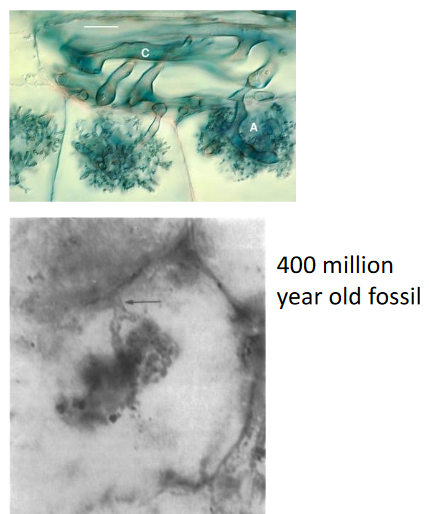
The friendship between plants and mycorrhizal fungi has been around for a super long time, like way before our grandparents were born. It’s like an ancient and widespread tradition in the plant world. In fact, most plants have the special tools needed to make this friendship happen.
Now, here’s something really fascinating. The partnership between plants and rhizobium bacteria, which helps with nitrogen, actually evolved from the machinery used in mycorrhizal friendships. It’s like taking something old and making it even better. So, in the future, when we understand all the details, we might be able to introduce this nitrogen-fixing ability into even more plant species. That would be a game-changer for farming and agriculture, like having a superpower for growing food!
8.5 Bad Microbial Interactions
You know how sometimes people get sick, and it’s not fun at all? Well, plants have their own version of that. Some tiny pests and pathogens, like little plant invaders, can make plants really sick.
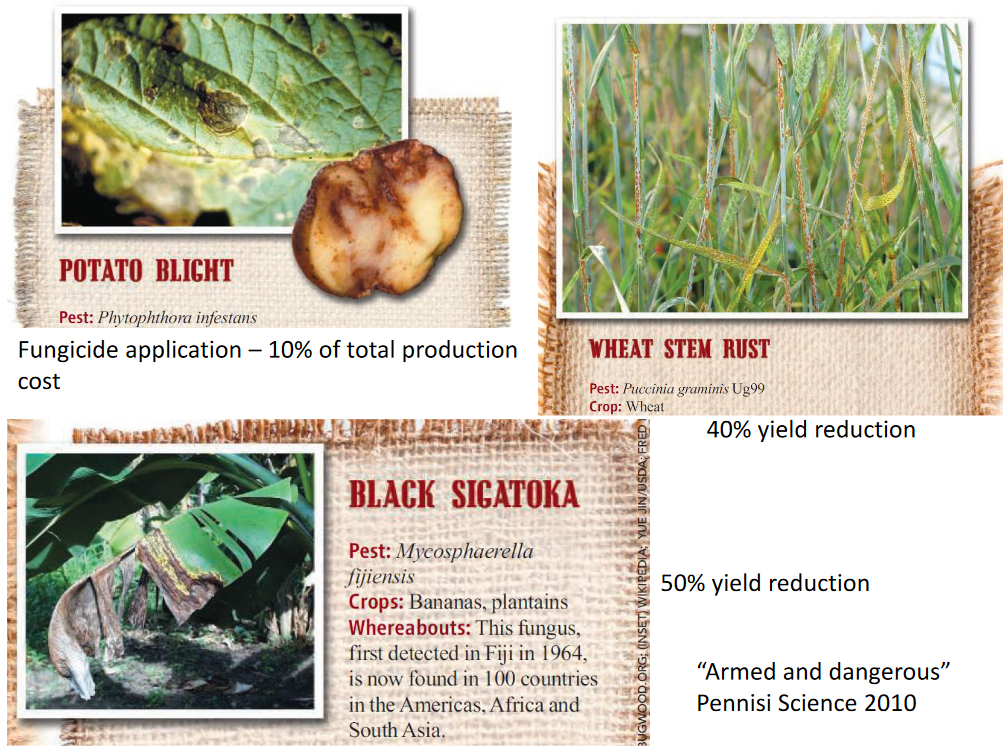
This is a big problem for farmers. Imagine if a lot of the food we grow got ruined by these plant-sickness-causing pests and germs. It would be like having less food to eat.
There are some famous examples of this. Back in 1840, there was something called the “Irish potato famine,” and it was caused by a nasty microorganism called “oomycete.” It wiped out a lot of potato crops, and that’s a big deal because potatoes are a major food source.
There’s also the story of the “black stem rust.” In the 1950s, this bad guy messed with the North American wheat crops, and it was a disaster. Wheat is used to make things like bread, and when the crops got sick, it affected what people could eat.
8.5.1 Kinds of Pathogens

Pathogens are like the “bad guys” that can make plants sick, but they come in different types:
Necrotrophs are like plant bullies. They first kill the plant’s cells and then eat what’s left. It’s kind of like breaking a toy and then playing with the broken pieces.
Biotrophs are more like plant squatters. They live inside the plant’s tissue, sort of like making a home there. But the interesting thing is, they don’t cause the plant’s death. It’s like having a roommate who doesn’t kick you out of your own house.
Hemibiotrophs are like shape-shifters. They can switch between being a friendly guest (biotroph) and turning into a plant bully (necrotroph). It’s like someone who can be nice one day and mean the next.
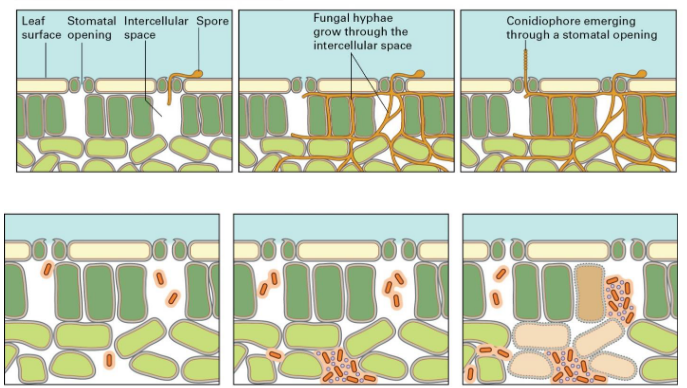
When a microbe infects a plant, it can do so via an opening.
8.5.2 Psueodmonas syringae

Imagine there’s a sneaky, hemibiotrophic bacterium called Pseudomonas syringae, and it plays a trick on some plant friends.
These bacteria make their home in the spaces between plant cells. You can see them because they light up with green and red colors, kind of like glow-in-the-dark toys.
Now, when these bacteria grow in number, they do something interesting. They use a special way (i.e., quorum sensing) to talk to each other, like having a secret code. When they’re all talking together, they switch into a “mean” mode. This means they start making things that can hurt the plant, like enzymes that break down the plant’s cell walls and other tricky molecules.
8.5.3 Biotrophic Fungi Strategies

So, here’s how some sneaky fungi work when they want to live inside a plant:
These fungi have a special trick up their sleeves. They make something called an “appressorium” to break through the plant’s protective wall. It’s like they create a tiny battering ram to get inside.
Once they’re inside, they form something called a “haustorium.” It’s like a cozy room they build within the plant cell. They even put up their own walls by making a special membrane.
The haustorium is like a super-efficient kitchen. It helps the fungus get more nutrients and water from the plant. It’s all about making the plant’s resources flow to the fungus, so it can grow and live happily inside.
8.5.4 PAMPS
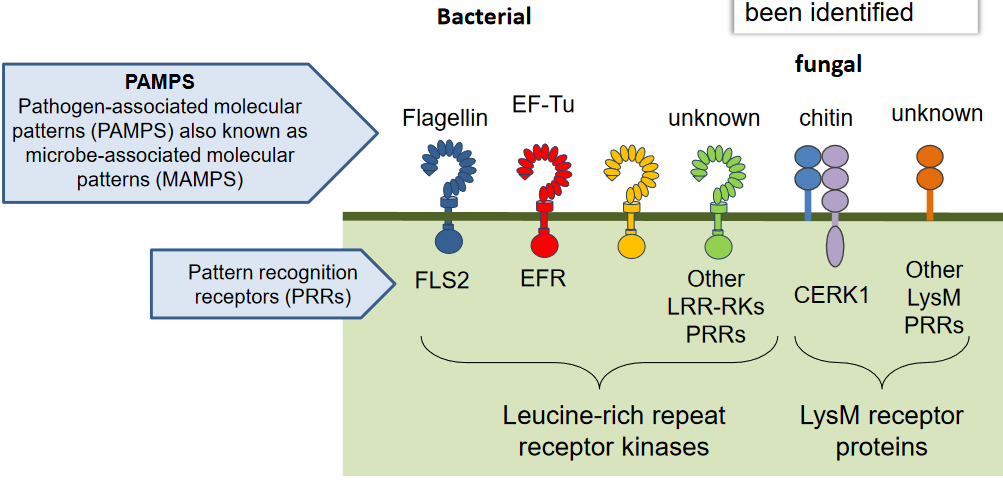
When a plant wants to spot a sneaky pathogen, it uses something like a secret code. This code is called “Pathogen-associated molecular patterns,” or PAMPS for short.
Now, PAMPS are like tiny clues that give away the pathogen’s presence. They’re a bit like leaving behind fingerprints at a crime scene. Only a few pairs of these codes and the plant’s “spotter” (we call it a PRR) have been discovered. It’s like finding a few secret handshakes that help the plant recognize the bad guys.
8.5.4.1 PAMP Recognition

Plants have special sensors to detect when something is wrong, kind of like an alarm system.
One of these sensors is called WAK1. It’s like a guard that watches out for pieces of the plant’s own cell wall. When it spots these fragments, it knows something is not right.
Another sensor is DORN1. It’s like a security camera that keeps an eye on something called extracellular ATP. This ATP is a sign that there might be damage to plant cells.

The above leads to the development of something called a pattern triggered immunity (i.e., PTI).
8.5.4.2 Recognitions of Symbionts

It’s like finding similarities between two superhero teams.
In one team, there’s a superhero called CERK1, and in another team, there’s a hero called NFR1. These heroes are kind of like cousins because they have a family connection, meaning they come from a similar background.
Now, both CERK1 and NFR1 have a special power called a “kinase.” This power helps them do important jobs. In one team, they use this power for defense, like protecting their team from bad guys. This is a really old and important job.
8.5.5 Making Reactive Oxygen Species (i.e., ROS)
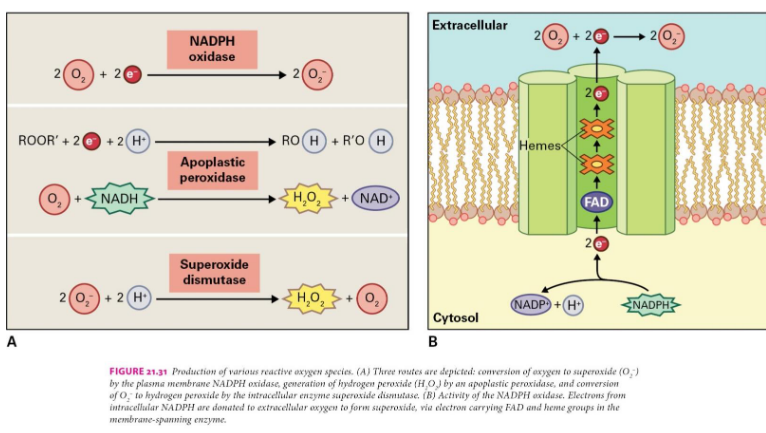
Plants have a secret weapon called ROS. It’s like their very own superhero.
When there’s trouble, ROS goes to work. It fights off bad guys like germs, and it also sends out signals to warn the plant that something’s wrong. It’s a bit like a security alarm that alerts the plant to danger.
ROS doesn’t stop there. It also helps the plant build up special compounds that can kill off the bad guys, kind of like plant bodyguards. Plus, it reinforces the plant’s walls to make it harder for the bad guys to get in.

When bad pathogens invade a plant, they have sneaky tricks up their sleeves. These tricks are like secret weapons.
One of these weapons is called an “effector.” Pathogens use effectors to mess with the plant’s defense system. It’s like a spy who goes inside the plant’s cells and tries to sabotage their protection.
These effectors are like little tools that the pathogen uses to make itself stronger and healthier. They might do things to stop the plant from fighting back, like interfering with the plant’s immune response.
8.5.5.1 Examples of Effectors

Imagine the bad pathogens have different tools in their toolbox to mess with the plant. Here are a few examples:
One tool, called Hop1, is used by a germ called Pseudomonas syringae. It’s like a tool that breaks the plant’s chloroplasts, which are important for plant energy. This makes the plant weak.
Another tool, known as AvrBs3, is used by a germ called Xanthomonas campestris. It’s like a tool that turns on certain genes in the plant. These genes help the germ survive and grow, making it more dangerous.
AvrPto is like a special tool from Pseudomonas syringae. It goes after something called FLS2, which is like a plant’s alarm system. This tool messes up the alarm so the plant can’t signal for help.
Then there’s Avr2, which is a tool that stops something called cysteine proteases. These proteases help the plant fight off the bad germs, so when Avr2 is used, the plant’s defenses become weaker.
8.6 Effector-Triggered Immunity (i.e., ETI)

When bad germs use their tricky tools (effectors) to mess with a plant, the plant has its own secret defense plan called “Effector-triggered immunity” or ETI. It’s like the plant’s superhero power.
In this defense plan, the plant has special genes (called “R” genes) that can recognize specific bad germ effectors. It’s like having a superhero radar that spots the enemy.
But here’s the catch: If either the specific effector or the superhero gene is missing, the plant’s immunity plan won’t work. It’s like Batman needing both his gadgets and his bat-suit to fight crime.
This plan works well for most plant germs that live inside the plant (biotrophic germs). And plant scientists can use this superhero power to make plants stronger by adding the R genes from wild plant relatives into the plants we grow in our gardens. It’s like giving our plants extra superpowers to fight off the bad germs.
8.6.1 R-Proteins and PRRs
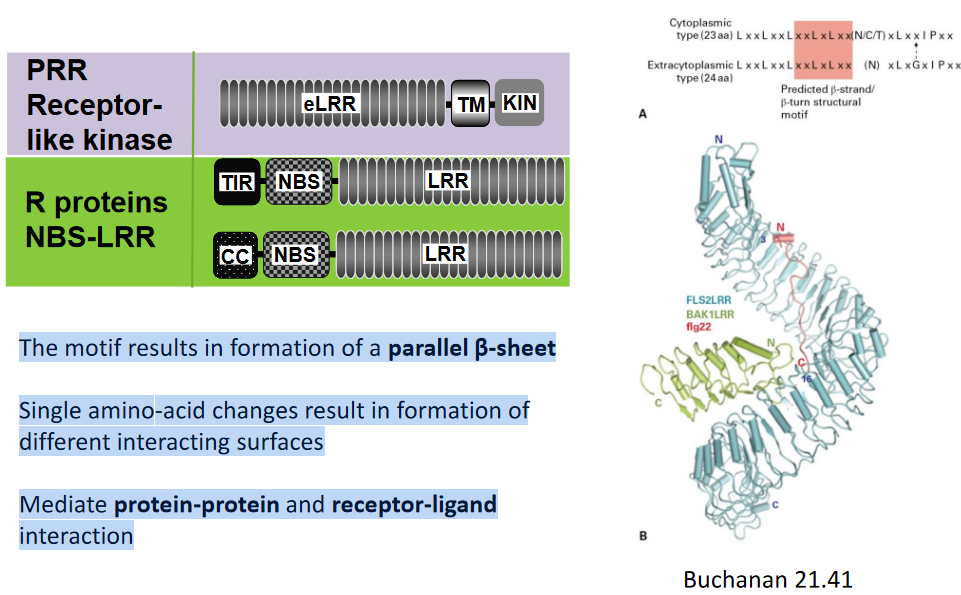
In plants, there are special proteins that help with recognizing and fighting off bad germs. These proteins have a unique part called “leucine-rich repeats” or LRR motifs.
Think of LRR motifs like puzzle pieces that plants use to connect with other proteins. When the pieces fit together, it’s like a handshake between proteins.
What’s really cool is that even a tiny change in one piece can create a completely different handshake. These handshakes are how proteins talk to each other.
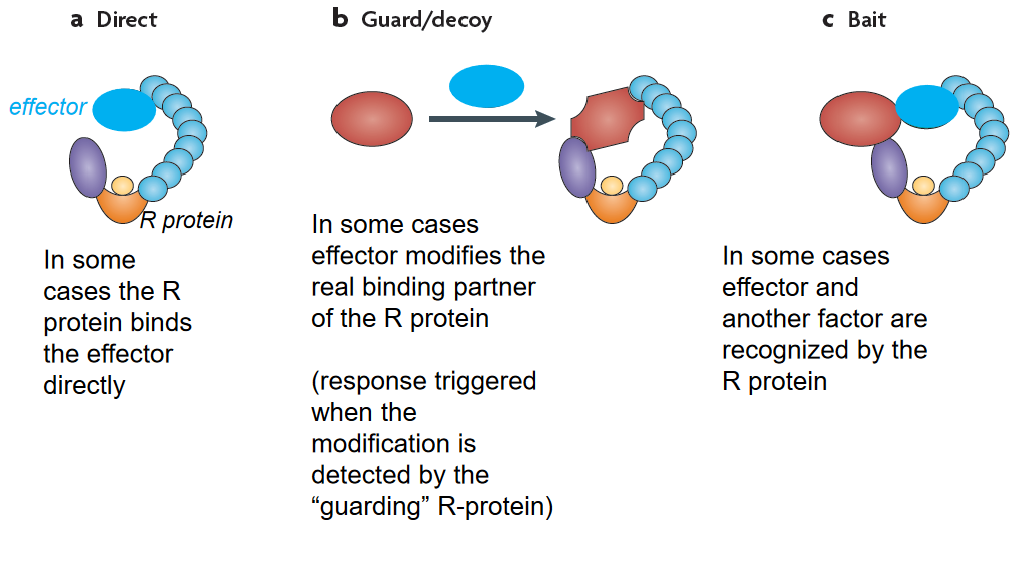
R-proteins act like guards against harmful invaders. These R-proteins have different ways to spot the bad guys.
Direct Recognition: Sometimes, the R-protein can see the invader directly, like looking at a wanted poster and saying, “I found you!”
Guard or Decoy: In other cases, the invader tries to change one of the R-protein’s friends. When the R-protein sees this change, it knows something’s wrong and sounds the alarm.
Bait: There are also times when the invader teams up with something else. The R-protein notices this partnership and knows there’s trouble.